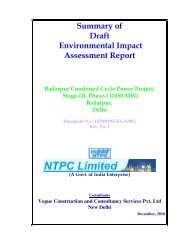proposed integrated complex for delhi judicial academy
proposed integrated complex for delhi judicial academy
proposed integrated complex for delhi judicial academy
Create successful ePaper yourself
Turn your PDF publications into a flip-book with our unique Google optimized e-Paper software.
Rapid Environmental Impact Assessment (REIA) Study <strong>for</strong> Proposed Integrated Complex <strong>for</strong> Delhi Judicial Academy,<br />
National Law School, and National Institute <strong>for</strong> Mediation & Conciliation at Dwarka, New Delhi<br />
6. BOD 3 @ 27 o C 150 – 250 mg/l<br />
7. COD 275 – 450 mg/l<br />
It is <strong>proposed</strong> to treat the wastewater through a full fledged decentralized STP based on Aerobic<br />
Fluidized Bed Reactor Technology. The STP will be set up <strong>for</strong> a mean daily flow rate of 10.42<br />
m 3 /hr., peak hourly flow rate of 20 m 3 /hr., and minimum flow rate of 4.5 m 3 /hr.<br />
The system will consist of a collection cum equalization tank where the waste water will be<br />
received and homogenized and equalized <strong>for</strong> the continuous operation of the treatment plant. It will<br />
be followed by primary clarifier to remove most of the suspended solids from the wastewater. The<br />
wastewater thereafter will flow to aerated fluidized bed reactor <strong>for</strong> the biological oxidation of the<br />
organics to reduce BOD and COD and also to reduce the bacterial population by order magnitude.<br />
A secondary clarifier will separate the microorganism in the <strong>for</strong>m of biological sludge to be<br />
recycled back to the aeration chamber. A sludge collection sump will be provided to collect the<br />
sludge. A sludge pump will dewater the sludge with a provision <strong>for</strong> recycle of sludge to the<br />
fluidized bed reactor during start up. Sludge filtration system will be provided in the <strong>for</strong>m of filter<br />
press. Treated wastewater will be chlorinated in the disinfection tank. An intermediate treated water<br />
storage tank will be provided <strong>for</strong> further tertiary treatment. The treated wastewater in tertiary<br />
treatment will pass through pressure sand filter <strong>for</strong> the final clarification. Activated carbon filter<br />
will be provided to remove the final traces of organic matters and make it suitable <strong>for</strong> reuse within<br />
the campus. A collection tank will be provided <strong>for</strong> collection and storage of the clear tertiary treated<br />
waste water <strong>for</strong> reuse within the campus.<br />
The disinfection will be carried out by means of chlorination. This will be done by the hypochlorite<br />
solution as the chlorinating agent. The hypochlorite solution is easily available in different<br />
concentration ranges with free chlorine content of 10% or more and is quite easy to handle because<br />
of operation at ambient pressure and being able to pump the liquid by means of normal dosing<br />
pumps.<br />
The treated wastewater will be used <strong>for</strong> flushing of toilets and in horticulture purpose within the<br />
<strong>proposed</strong> <strong>complex</strong>.<br />
The expected characteristics of the treated wastewater after secondary and tertiary treatment<br />
process are given in Table 5.4.<br />
107
















